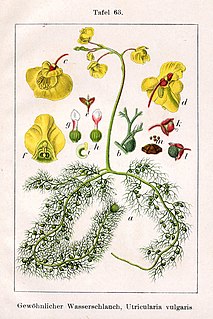
Utricularia, commonly and collectively called the bladderworts, is a genus of carnivorous plants consisting of approximately 233 species. They occur in fresh water and wet soil as terrestrial or aquatic species across every continent except Antarctica. Utricularia are cultivated for their flowers, which are often compared with those of snapdragons and orchids, especially amongst carnivorous plant enthusiasts.

Utricularia gibba, commonly known as the humped or floating bladderwort, is a small, mat-forming species of carnivorous aquatic bladderwort. It is found on all continents except Antarctica.
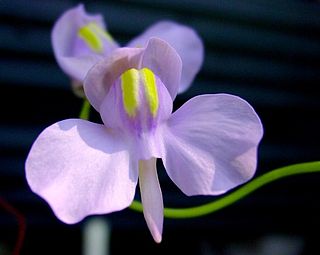
Utricularia nelumbifolia is a large perennial aquatic carnivorous plant that belongs to the genus Utricularia. U. nelumbifolia is endemic to Brazil. It was originally published and described by George Gardner in 1842. Its habitat is reported as being restricted to the water-filled leaf axils of Vriesea species, which are bromeliads, in arid volcanic locations at altitudes from 800 m (2,625 ft) to 2,200 m (7,200 ft). U. nelumbifolia will produce aerial stolons that descend into nearby leaf axils in order to colonize new territory, similar to the habit of U. humboldtii. It typically flowers from May to August.
Utricularia praetermissa is a medium-sized epiphyte or terrestrial carnivorous plant that belongs to the genus Utricularia. U. praetermissa is endemic to Central America, where it is found in Costa Rica, Nicaragua, and Panama. It was originally published and described by Peter Taylor in 1977. It grows on wet trees and banks in cloud forests at altitudes from 1,000 m (3,281 ft) to 2,800 m (9,186 ft). It flowers between July and October.
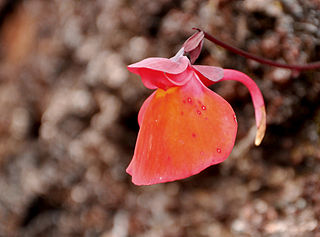
Utricularia quelchii is a small perennial, epiphyte or terrestrial carnivorous plant that belongs to the genus Utricularia. U. quelchii is endemic to the Guyana Highland region of Guyana and Venezuela with one collection from Brazil. It was originally published and described by N. E. Brown in 1901. It grows on wet, mossy rocks or banks in swamps and around low tree trunks and branches and sometimes in the water-filled leaf axils of the bromeliad Brocchinia species. It is typically found at altitudes around 2,000 m (6,562 ft), but has been recorded from altitudes of 1,400 m (4,593 ft) to 2,800 m (9,186 ft), the highest collections representing specimens from Roraima.

Utricularia reniformis is a large perennial carnivorous plant that belongs to the genus Utricularia. U. reniformis is endemic to Brazil. It was originally published and described by Augustin Saint-Hilaire in 1830. It usually grows as a terrestrial plant in wet grasslands and only sometimes as an epiphyte in the water-filled leaf axils of some bromeliad species. It is typically found between altitudes of 750 m (2,461 ft) and 1,900 m (6,234 ft) in its southern range and up to 2,500 m (8,202 ft) in its northern range. It has been collected in flower between October and March.
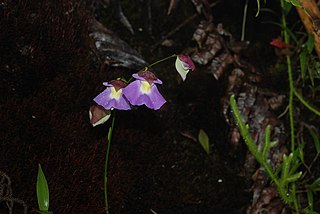
Utricularia unifolia is a medium-sized perennial carnivorous plant that belongs to the genus Utricularia. U. unifolia is native to Central America and western South America. It was originally published and described by Hipólito Ruiz López and José Antonio Pavón Jiménez in 1797 and later considered a synonym of Utricularia alpina until Peter Taylor's 1989 monograph on the genus where he restored the species as distinct from U. alpina. It grows as a terrestrial or epiphytic plant on moss-covered trees, rocks, or banks in cloud forests at altitudes between 2,000 m (6,562 ft) and 3,000 m (9,843 ft). U. unifolia usually produces only one leaf, which is where the species epithet "unifolia" is derived from.
Utricularia podadena is a small, probably perennial, terrestrial carnivorous plant that belongs to the genus Utricularia and is the only member of Utricularia sect. Candollea. U. podadena is endemic to Malawi and Mozambique, being known only from the type location in Malawi and from one other collection in Mozambique. As of Peter Taylor's 1989 monograph on the genus, more recent efforts to locate this species have failed. It was originally published and described by Taylor in 1964 and placed in its own section, Candollea, in 1986. It grows as a terrestrial plant in marshy grasslands in the presence of Loudetia species at altitudes of around 1,000 m (3,281 ft). It flowers in July. It is a very distinct plant in the genus with the long stipitate glandular trichomes covering the flower. Its affinities within the genus are not clear.
Utricularia hirta is a small, probably perennial, terrestrial carnivorous plant that belongs to the genus Utricularia. U. hirta is native to India and Southeast Asia, where it can be found in Bangladesh, Cambodia, Laos, Sri Lanka, Thailand, and Vietnam and on the island of Borneo. It was originally named by Jacob Theodor Klein and formally described and published by Johann Heinrich Friedrich Link in 1820. It grows as a terrestrial plant in damp or wet open areas or marshes at altitudes from sea level to 1,000 m (3,281 ft). It has been collected in flower between July and December.
Utricularia tenuissima is a small, annual, terrestrial carnivorous plant that belongs to the genus Utricularia and is the only member of Utricularia sect. Martinia. U. tenuissima is endemic to South America, where it can be found in Brazil, Colombia, Guyana, Suriname, Trinidad, and Venezuela. It grows as a terrestrial plant in wet, open savanna usually in sand at altitudes from sea level to 2,100 m (6,890 ft). It was originally published and described by Thomas Gaskell Tutin in 1934 and placed in its own section, Martinia, in 1986 by Peter Taylor.
Utricularia appendiculata is a medium-sized, probably perennial, terrestrial carnivorous plant that belongs to the genus Utricularia and is the only member of Utricularia sect. Oliveria. U. appendiculata is endemic to Africa, where it can be found in Burundi, Cameroon, the Central African Republic, the Democratic Republic of the Congo, Gabon, Madagascar, Malawi, Mozambique, Tanzania, Uganda, and Zimbabwe. It grows as a terrestrial plant in wet Sphagnum bogs, damp sandy savannas, or in peaty marshes at altitudes from 1,500 m (4,921 ft) to 1,860 m (6,102 ft), but as low as 700 m (2,297 ft) in the Central African Republic. It flowers mostly in the wet season. It was originally published and described by Eileen Adelaide Bruce in 1933 and was placed in its own section, Oliveria, in 1986 by Peter Taylor.
Utricularia viscosa is a small to medium sized perennial, terrestrial or subaquatic carnivorous plant that belongs to the genus Utricularia and is the only member of Utricularia sect. Sprucea. U. viscosa is native to Central America and South America. It grows as a terrestrial or subaquatic plant in wet sandy savannas at lower altitudes but as high as 900 m (2,953 ft) in Guyana. It was originally named by Richard Spruce and formally described by Daniel Oliver in 1860. In 1986, Peter Taylor placed this species in its own section, Sprucea, which was named in honor of Richard Spruce.

Utricularia cornuta, the horned bladderwort, is a small to medium-sized, probably perennial carnivorous plant that belongs to the genus Utricularia. U. cornuta is endemic to North America and can be found in the Bahamas, Cuba, Canada, and the United States. It grows as a terrestrial or subaquatic plant in marshes, swamps, and pools in shallow waters, mostly at lower altitudes. It was originally described and published by André Michaux in 1803.
Utricularia longeciliata is a small to medium-sized perennial carnivorous plant that belongs to the genus Utricularia. U. longeciliata is endemic to South America, where it can be found in Brazil, Colombia, Guyana, Suriname, and Venezuela. It grows as a terrestrial plant in damp, sandy soils at altitudes from near sea level to 1,400 m (4,593 ft). It flowers throughout the year in its native range. U. longeciliata was originally described and published by Alphonse Pyrame de Candolle in 1844.
Utricularia microcalyx is a small to medium-sized annual carnivorous plant that belongs to the genus Utricularia. It is native to tropical Africa, where it can be found in the Democratic Republic of the Congo and Zambia. U. microcalyx grows as a terrestrial plant in damp, sandy or peaty soils in grasslands at altitudes from 1,200 m (3,937 ft) to 1,650 m (5,413 ft). It typically flowers between February and July. It was originally described and published by Peter Taylor in 1964 as a variety of U. welwitschii. Taylor elevated this variety to the species level in 1971.
Utricularia odontosepala is a small to medium-sized, probably annual, carnivorous plant that belongs to the genus Utricularia. It is native to tropical Africa, where it can be found in the Democratic Republic of the Congo, Malawi, and Zambia. U. odontosepala grows as a terrestrial plant in damp, peaty soils in grasslands at altitudes from 1,300 m (4,265 ft) to 2,200 m (7,218 ft). It typically flowers between April and September. It was originally described and published by Otto Stapf in 1912. Peter Taylor later reduced the species to a variety of U. welwitschii in 1964 but then reversed his decision and reestablished Stapf's original treatment of the species.
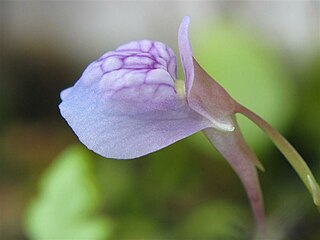
Utricularia graminifolia is a small perennial carnivorous plant that belongs to the genus Utricularia. It is native to Asia, where it can be found in Burma, China, India, Sri Lanka, and Thailand. U. graminifolia grows as a terrestrial or affixed subaquatic plant in wet soils or in marshes, usually at lower altitudes but ascending to 1,500 m (4,921 ft) in Burma. It was originally described and published by Martin Vahl in 1804. It has also recently been grown in planted aquaria.

Utricularia reticulata is a medium to large-sized, probably annual carnivorous plant that belongs to the genus Utricularia. It is native to India and Sri Lanka. U. reticulata grows as a terrestrial or subaquatic plant in marshy grasslands or wet soils over rocks at lower altitudes up to 750 m (2,461 ft). It is also a common weed found in rice fields. U. reticulata was originally described by James Edward Smith in 1808, but he did not cite a specimen and instead referred to a botanical print in Hendrik van Rheede's 1689 Hortus Malabaricus.
Utricularia smithiana is a medium-sized, probably perennial carnivorous plant that belongs to the genus Utricularia. It is endemic to India. U. smithiana grows as a terrestrial or affixed subaquatic plant in swamps or shallow water pools at medium and high altitudes. It was originally described by Robert Wight in 1849, reduced to a variety of U. caerulea by Charles Baron Clarke in 1884, and later reinstated as U. smithiana.
Utricularia kumaonensis is a small annual carnivorous plant that belongs to the genus Utricularia. It is native to Bhutan, northern Burma, the Yunnan province of China, India, and Nepal. U. kumaonensis grows as a lithophyte, epiphyte, or terrestrial plant on mossy rocks or in bog grasslands at altitudes from 2,250 m (7,382 ft) to 4,200 m (13,780 ft). It was originally described by Daniel Oliver in 1859, although Peter Taylor asserted in his 1989 monograph that Michael Pakenham Edgeworth's 1847 description of Diurospermum album is U. kumaonensis. It is very similar to U. multicaulis.









